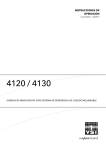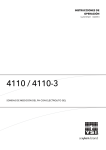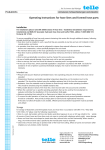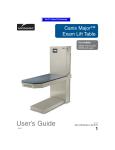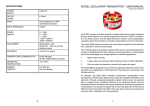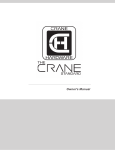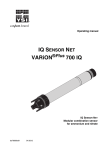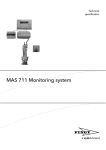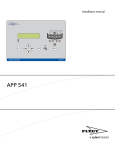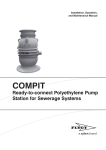Download YSI MultiLab IDS 4210 ORP Electrode User Manual
Transcript
OPERATIONS MANUAL ba76138e01 4210 ORP ELECTRODE 02/2013 4210 For the most recent version of the manual, please visit www.ysi.com. Contact Copyright 2 YSI 1725 Brannum Lane Yellow Springs, OH 45387 USA Tel: +1 937-767-7241 800-765-4974 Email: [email protected] Internet: www.ysi.com © 2013 Xylem Inc. ba76138e01 02/2013 4210 General information General information Automatic sensor recognition The sensor electronics with the stored sensor data is in the connecting head of the electrode. The data include, among other things, the sensor type and series number. The data is recalled by the meter when the sensor is connected and is used for measurement and for measured value documentation. The digital transmission technique guarantees the failure-free communication with the meter even with long connection cables. If the sensor firmware is enhanced by YSI, it can be updated via the meter. Technical data Reference electrolyte 3 mol/l KCl, Ag+free Junction Ceramic Electrode material and shape Platinum / circle Measurement and application characteristics mV measuring range - 1250.0 ... + 1250.0 Allowed temperature range 0 ... 100 °C (32 ... 212 °F) Typical application Laboratory Shaft dimensions, material, electrical connection Shaft length 120 mm Shaft diameter 12 mm Shaft material Glass Combination electrode connection Fixed cable Meter connection Digital plug Length 1.5 m Diameter 4.3 mm Smallest allowed bend radius Fixed installation: Flexible use: Plug type Socket, 4 pins Measured parameter Accuracy (± 1 digit) U [mV] ± 0.2 General data Connection cable Accuracy of the IDS measuring technique ba76138e01 02/2013 20 mm 60 mm 3 Commissioning, measuring, checking 4210 Commissioning, measuring, checking Note For ORP electrodes with platinum electrode, please follow the instructions in section ACTIVATING PLATINUM ELECTRODES. Commissioning Prepare the electrode for measuring as follows: Open the refilling opening for the reference electrolyte solution. Depending on the model, the stopper of the refilling opening is an elastomer stopper or a slider. The refilling opening must always be open during measurement! Refilling opening Remove the watering cap from the electrode tip. Possible salt deposits in the area of the watering cap do not affect the measuring characteristics and can easily be removed with deionized water. Note Please keep the watering cap. It is required for the electrode to be stored. Always keep the watering cap clean. Connect the combination electrode to the meter. Measure with the electrode according to the operating manual of the meter and observe the following rules while doing so: General rules for measuring Make sure the refilling opening for the reference electrolyte solution is open. Avoid the carryover of sample solution from one measurement to the next as follows: – Shortly rinse the sample beakers with the solution the beakers are to be filled with next. – Between measurements, rinse the electrode with the solution that follows. Alternatively, you can also rinse the electrode with deionized water and then carefully dab it dry. Immerse the electrode in the solution in a vertical or slightly tilted position. Make sure the immersion depth is correct. The junction must be completely submersed in the solution. The junction is in the area of the bottom end of the shaft (see arrow). 4 ba76138e01 02/2013 4210 Commissioning, measuring, checking 4210 At the same time, the level of the reference electrolyte must be at least 2 cm above the level of the solution. Conversion to normal hydrogen electrode UH = UMeas + URef with: UH = ORP, referring to the normal hydrogen electrode UMeas = Measured ORP URef = Voltage of the reference system compared to the normal hydrogen electrode URef is temperature dependent and can be taken from the following table (see also DIN 38404-6): T (°C) T (°F) URef [mV] T (°C) T (°F) 4210 ba76138e01 URef [mV] 4210 0 32 +224 35 95 +200 5 41 +221 40 104 +196 10 50 +217 45 113 +192 15 59 +214 50 122 +188 20 68 +211 55 131 +184 25 77 +207 60 140 +180 30 86 +203 02/2013 5 Commissioning, measuring, checking Checking with Zobell ORP buffer solution (YSI 3682) 4210 U is temperature dependent and can be taken from the following table: T (°C) U [mV] T (°C) 4210 6 U [mV] 4210 0 +262 30 +214 5 +254 35 +206 10 +246 40 +199 15 +238 45 +191 20 +230 50 +183 25 +222 ba76138e01 02/2013 4210 Aging Storage During short measuring breaks Immerse the electrode in the reference electrolyte with the refilling opening open. Electrode Reference electrolyte Model (see page 10) 4210 3 mol/l KCl, Ag+free KCl-250 (250 ml) Prior to the next measurement, shortly rinse the electrode with the test sample or deionized water. Overnight or longer Insert the clean electrode into the watering cap filled with reference electrolyte and shut the refilling opening. Note During longer storing periods, salt sediments may develop on the watering cap. They do not affect the measuring characteristics and can easily be removed with deionized water when the electrode is put into operation again. Aging Every ORP electrode undergoes a natural aging process. Extreme operating conditions can considerably shorten the lifetime of the electrode. These are: Strong acids or lyes, hydrofluoric acid, organic solvents, oils, fats, bromides, sulfides, iodides, proteins High temperatures High changes in pH and temperature. The warranty does not cover failure caused by measuring conditions and mechanical damage. ba76138e01 02/2013 7 Aging 4210 Maintenance and cleaning During operation, a small amount of reference electrolyte leaks through the junction from the electrode into the test sample. If the level of reference electrolyte becomes too low with time, refill it through the refilling opening. Refilling the reference electrolyte Refilling is very easy using a dropping bottle. Proceed as follows: Cut off the tip of the dropping bottle at a right angle until the opening in the tip can be seen Open the refilling opening of the electrode Press the tip of the dropping bottle into the refilling opening while turning it slightly Pump several small quantities of the reference electrolyte into the stem using the dropper bottle Pull the dropping bottle out of the refilling opening while turning it slightly as necessary. 8 ba76138e01 02/2013 4210 Activating platinum electrodes Cleaning Remove water-soluble contamination by rinsing with deionized water. Remove other contamination as follows: Contamination Cleaning procedure Fat and oil Rinse with water containing household washing-up liquid Lime and hydroxide deposits Rinse with citric acid (10 % by weight) After cleaning Rinse the electrode with deionized water. Activating platinum electrodes First-time activation during installation and as required For first-time activation use the activation powder from the SORT/RH reagent set (component of the SORT/RH reagent set). Immerse the moist (but not dripping) platinum electrode into the activation powder and rotate the electrode several times in the powder. Then remove the activation powder under flowing water with a soft brush (e.g. toothbrush). Activation during very long set-up times When changing from oxidizing to reducing test solutions and vice versa this can result in set-up times that can take significantly more than an hour. In this case pretreatment (activation) of the platinum surface can shorten the set-up time. The type of pretreatment (reducing or oxidizing) is based on the pH value and the ORP voltage (UH) of the test solution where the latter must be estimated for the first measurement. The type of pretreatment can then be determined using the following diagram where UH is based on the normal hydrogen electrode: 1000 UH in mV 800 oxidizing pretreatment 600 400 reducing pretreatment 200 0 0 ba76138e01 02/2013 2 4 6 8 10 12 14 pH value 9 Wear parts and accessories Oxidizing pretreatment 4210 Immerse the platinum electrode for two to three days in a sulfuric acid clorina solution (0,5 g clorina powder, 100 ml H2O dist., 2-3 ml 20% sulfuric acid). Clorina powder for producing the solution is included in the SORT/RH reagent set. Note: The diaphragm must not be immersed in the clorina solution! Reducing pretreatment When the electrode is ready for the test immerse it in the Zobell ORP buffer solution and wait for a stable measured value. Wear parts and accessories 10 Description Model Order no. Reference electrolyte solution 3 mol/l KCl, Ag+ free (250 ml) KCl-250 109 705Y Reagent set for regenerating ORP platinum electrodes, consisting of 10 g activation powder and 30 g clorina powder SORT/RH 109 730Y Zobell ORP buffer solution (125 ml) 3682 061320 ba76138e01 02/2013 4210 Contact Information Contact Information Ordering & Technical Support Telephone: (800) 897-4151 (937) 767-7241 Monday through Friday, 8:00 AM to 5:00 PM ET Fax: (937) 767-1058 Email: [email protected] Mail: YSI Incorporated 1725 Brannum Lane Yellow Springs, OH 45387 USA Internet: www.ysi.com When placing an order please have the following information available: YSI account number (if available) Model number or brief description Quantity Name and Phone Number Billing and shipping address Purchase Order or Credit Card Service Information YSI has authorized service centers throughout the United States and Internationally. For the nearest service center information, please visit www.ysi.com and click ‘Support’ or contact YSI Technical Support directly at 800-897-4151. When returning a product for service, include the Product Return form with cleaning certification. The form must be completely filled out for an YSI Service Center to accept the instrument for service. The Product Return form may be downloaded at www.ysi.com and clicking on the ‘Support‘ tab. ba76138d01 02/2013 11 Contact Information 12 4210 ba76138d01 02/2013 Xylem |'zīləm| 1) The tissue in plants that brings water upward from the roots; 2) a leading global water technology company. We're 12,500 people unified in a common purpose: creating innovative solutions to meet our world's water needs. Developing new technologies that will improve the way water is used, conserved, and re-used in the future is central to our work. We move, treat, analyze, and return water to the environment, and we help people use water efficiently, in their homes, buildings, factories and farms. In more than 150 countries, we have strong, long-standing relationships with customers who know us for our powerful combination of leading product brands and applications expertise, backed by a legacy of innovation. For more information on how Xylem can help you, go to www.xyleminc.com YSI 1725 Brannum Lane Yellow Springs, OH 45387 Tel: +1 937-767-7241; 800-765-4974 Fax: +1 937-767-1058 Email: [email protected] Web: www.ysi.com ©Xylem Inc















